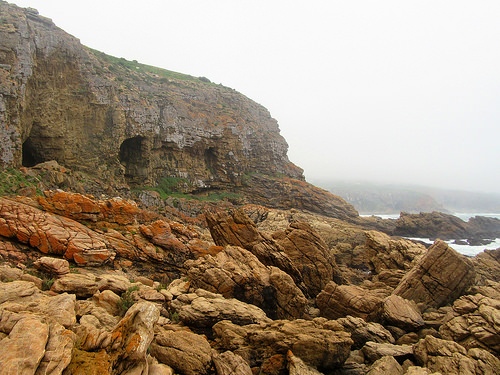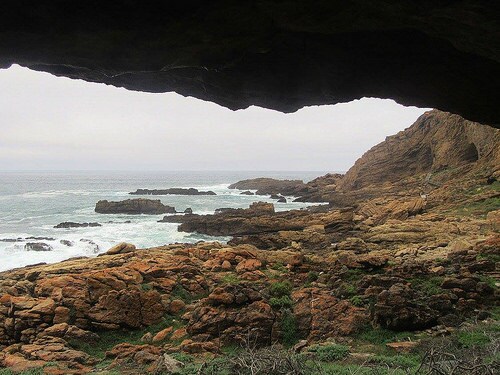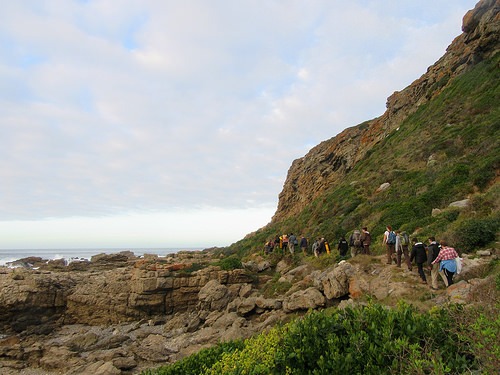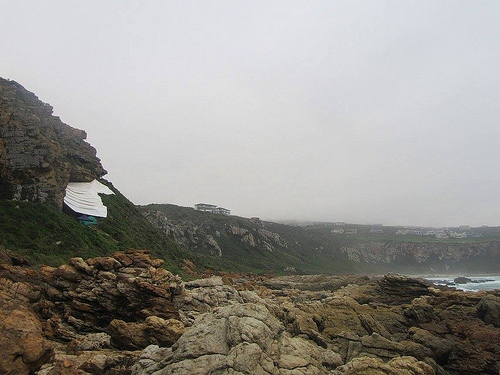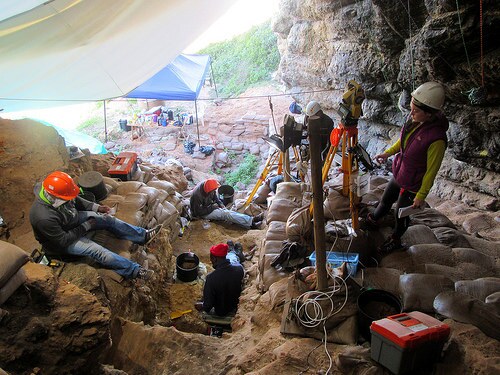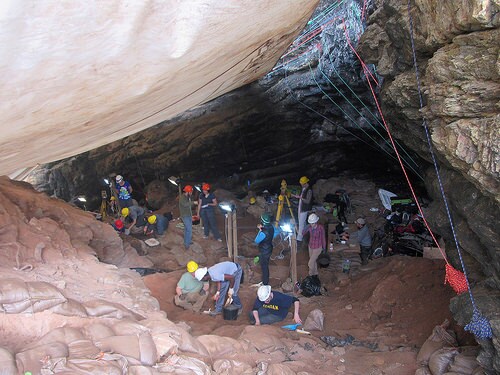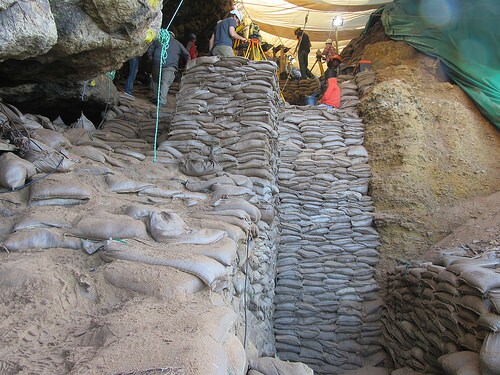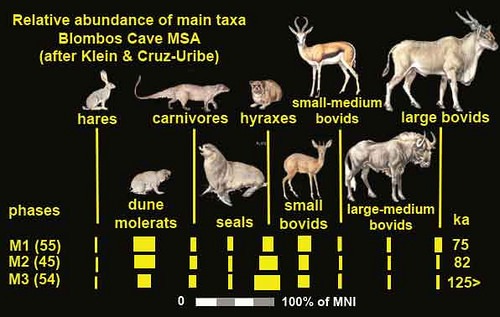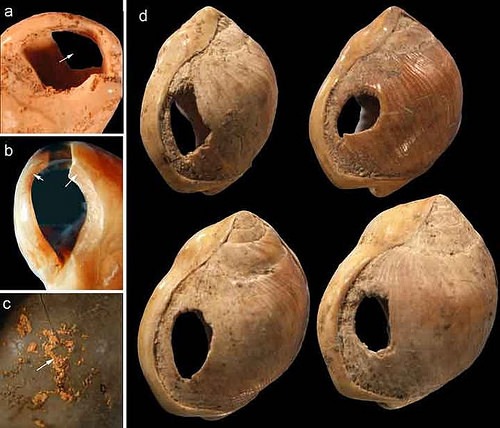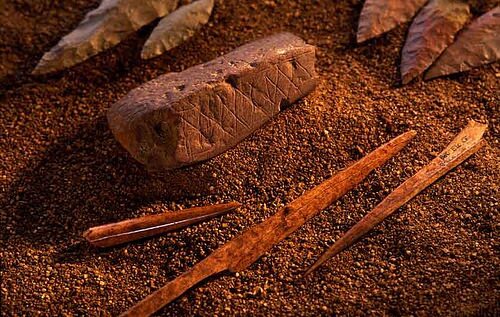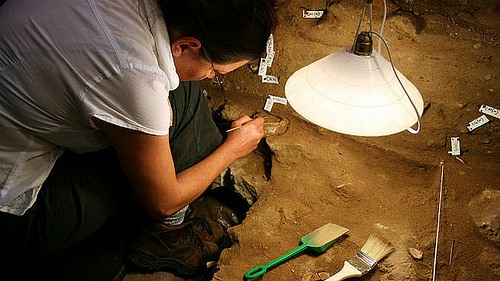
In this place, you can peer out over a grand oceanic vista. Standing on the top of a cliff and looking down, you see waves crash against rugged rock formations of various hues of brown—natural stone monuments sculpted by wind, water and time. If you look more closely, you can see dolphins among the waves and seals on the rocks. It’s perfect coastal hiking territory.
The coast of northern California?
Think again.
You’re on the southeastern coast of South Africa, on a rocky headland called Pinnacle Point just south of the town of Mossel Bay.
Other than its majestic scenery, Pinnacle Point would mean little to most people. But for archaeologists and others who know about its significance, it is one of a number of locations where evidence has been found bearing on the dawn of modern humans. People lived here as long ago as 100,000 years and more—near the beginnings of modern humanity in terms of modern human behavior, as the current thinking goes. (Archaeological and genetic research has shown that the first modern humans ancestral to our current populations likely arose at least 160,000 to 200,000 years ago).
For almost countless millennia to the present, cave shelters have helped to define the coastline cliffs here. They have also helped to define a relatively good living for prehistoric people. One of these shelters, designated by archaeologists as ‘PP13B’, was first excavated more than a decade ago by an international team under the direction of palaeoanthropologist Curtis Marean of the Institute of Human Origins at Arizona State University. He and his team are still excavating at Pinnacle Point, which also includes a second cave shelter known as PP 5-6. Between the two shelters, scientists have uncovered a wealth of information that has enlightened current understanding about what kind of people these early occupants were and what they could tell us about human evolution and human behavior tens of thousands of years ago.
_______________________________________________
View looking down at the Pinnacle Point cave shelter area. Courtesy Kate Leonard
_______________________________________
View of Pinnacle Point cave shelters. Courtesy Kate Leonard
__________________________________________________
View toward the ocean looking out of a cave shelter at Pinnacle Point. Courtesy Kate Leonard
_______________________________________
Kate’s brush with prehistory
For a brief time in early 2016, Kate Leonard, a young Canadian PhD-credentialed archaeologist, joined the team as part of her global year-long journey to work at twelve different archaeological sites in 12 separate countries. She calls her project Global Archaeology: A Year of Digs. Popular Archaeology has been following her on her journey as she makes her rounds across the world. Pinnacle Point now makes the 5th stop on her global trek.
As part of any dig crew, Leonard knows that there are sometimes a few challenges that come with the outdoor experience of a dig, and Pinnacle Point was no exception. “To reach the site itself,” says Leonard, “the team walks down a long wooden staircase — that can be a bit slippery after a rainfall — and along the coastline. After a long day of digging it can be daunting to look up at all those steps with your frame-pack loaded with archaeological gear. Because the site is inaccessible except by foot much of the valuable equipment has to be trekked in and out by the team members.”
But there are benefits.
“A very positive aspect of this trek is the beautiful view over the Indian Ocean: it was wonderful to see the sunrise over the waves as we headed to the site in the morning,” she adds. But even more satisfying, as Leonard would be the first to say, is the opportunity to be a critical part of a major scientific investigation at a site that is having a salient impact on our understanding of human evolution. Archaeology at Pinnacle Point has been one of those undertakings leading the way. “All archaeological investigations are important and further our understanding of why humans do the things we do,” Leonard states. “But to be revealing evidence of human activity from so long ago is an even greater responsibility.”
Unlike excavating great ancient monumental structures of more recent human history, the investigation and retrieval of evidence of human occupation at prehistoric sites require recognizing and recovering objects and material that are generally far more subtle. It often requires the application of advanced techniques in the most careful way possible. “Archaeology is ‘preservation through destruction’: you only get one chance to put your trowel in the ground because after you remove the archaeological material it can never be put back,” explains Leonard. “That is why the work of recording the excavation process is so essential. At Pinnacle Point the level of detail being recorded is truly astounding. We plot every ‘find’ with no size restriction – so even pieces of shell that are 0.25 cm in size are digitally mapped with the total station [a high-tech piece of survey equipment that makes digital 3D maps]. This creates a rich database of information that can be intensively analyzed. When over 50,000 artifacts are being collected over the course of one field season precision and organization is paramount!”
Unique to the Pinnacle Point excavation is the integration of bar code scanners to record artifacts, archaeological features and buckets of sieved soil. The scanners are connected to hand-held computers, which are in turn connected to a total station. Currently, the excavation team is focusing on shelter PP 5-6, where they have set up 5 total stations with two team members functioning as site recorders moving among the excavators to carefully record the data with tablets. “There is a lot riding on the site recorders,” says Leonard, who worked as one of the recorders. “They have to ensure that all data is logged correctly and nothing is left out. It is amazing to see the activity on site with excavators furiously digging, the site recorders moving between their workstation and the excavators, and the 5 total stations being run simultaneously to keep up with the amount of archaeology being revealed.”
_______________________________________
The team walking to the site in the morning. Courtesy Kate Leonard
___________________________________________________
Pinnacle Point (PP) Cave 5-6 (left). Courtesy Kate Leonard
________________________________________
The team working at the lower end of the excavation in PP 5-6. Courtesy Kate Leonard
_______________________________________
The team at work in the upper portion of the excavation. Courtesy Kate Leonard
_____________________________________________________
A view of the long section in PP 5-6. This shows 40,000 years of stratigraphy. The base yielded material from 90,000 years ago. Courtesy Kate Leonard
_____________________________________________________
The finds and what they mean
Exploration at Pinnacle Point has taken scientists to a series of cave shelter sites. But the two cave shelters, PP13B and PP5-6, have stood out most prominently in the ongoing investigations. Cave PP13B alone has provided a glimpse of the surprisingly early sophistication and innovation of our modern human ancestors. “It has given us the earliest evidence for human consumption of shellfish – dated to around 164,000 years ago,” says Leonard. “Shellfish collecting can only be done at low spring tide (a new and full moon) and therefore a knowledge/awareness of the lunar cycle is implied. Once this knowledge began to be implemented to harvest shellfish the people living at Pinnacle Point had a predictable source of calorie rich protein with which to supplement their diet.” Cave PP13B also contained evidence for early use of ochre pigment and heat treatment of stone artifacts.” (See videos below. While viewing, note there is a momentary pause between each taping session within each video.)
Cave shelter PP5-6, where the team is now working, has added yet more. Containing material dated from 50,000 to 90,000 years ago, it has provided the earliest known evidence for the knapping of microliths to make composite tools, including intentional heat treatment of the stone. “This may be the earliest evidence for projectile points around 71,000 years ago, and to make those microliths they focused on heat treatment to improve the stone,” Leonard adds. Using the controlling elements of simple hearths, the shelter occupants employed a complex process to heat the stone (in this instance silcrate) and thus change its properties for better flaking to produce the micro blades or microliths for more advanced toolmaking. Many scientists consider this to be the foundation for pyrotechnology and a precursor to later technologies, such as the making of ceramics and the manufacturing of metals.
And that’s not all. “The types of innovations that have been revealed by the excavations in the Pinnacle Point complex share some major traits: cooperation, organization and planning,” says Leonard. And these were critical to the later development of agriculture and urbanization, basic elements of civilization.
______________________________________
_______________________________________________________
_______________________________________________________
Blombos
At first blush, there is nothing extraordinary about it. Carved out of a limestone cliff by nature millions of years ago, Blombos Cave is, like the Pinnacle Point caves, set picturesquely above a rugged seascape along South Africa’s Southern Cape Coast. And like Pinnacle Point, it may be without argument one of the most important locations yet discovered that holds evidence, with secrets perhaps yet to be revealed, bearing on the origins of modern humans.
_________________________________________
Blombos Cave interior panorama view. Image courtesy of Magnus Haaland
__________________________________
The significance of the cave was first discovered in 1991 when Professor Christopher Henshilwood of the University of the Witwatersrand in Johannesburg, South Africa, and others began serious investigations of the cave features. Systematic excavations were carried out beginning in 1997 with Cedric Poggenpoel and a team of excavators. It soon proved to be a goldmine of evidence that could potentially rewrite the scenario of when and where behaviorally modern humans emerged.
Most scientists at this time had assumed, based on evidence uncovered in the prehistoric cave sites of Europe, that modern human behavior, the ability to think and express abstractly, innovate, cooperate and communicate with symbolic expression, was born up north, in or near the Ice Age environs of present-day Europe, among anatomically modern humans who coexisted with their stalky, robust but perhaps less cognitively endowed Neanderthal cousins. But with the work of Henshilwood and others it was now beginning to appear that there was another story—a southside story—a story that played out far earlier in time near the southern Cape of South Africa. Scientists had unearthed 75,000-year-old pieces of ochre engraved with abstract designs, 75,000-year-old beads made from Nassarius (sea tick) shells, and 80,000-year-old bone tools, as well as human teeth with crown diameters that suggested that the people in the cave were likely anatomically modern. Moreover, evidence of shellfishing and possibly fishing had been discovered, dating to about 140,000 years ago. The engraved pieces of ochre have been regarded by many scientists as the oldest known artwork. According to Henshilwood and his associates, the use of abstract symbolism as demonstrated on the engraved pieces of ochre and the presence of a complex tool kit suggested that a Middle Stone Age (MSA) people [280,000 – 25,000 B.P.] were behaving in a “cognitively modern way” and may have exercised syntactical language, the rudiments of modern-day language communication, at least 80,000 years ago.
Since the earliest investigations beginning in 1991, teams of researchers at the cave have revealed evidence bearing on at least several elements of human cultural activity. For recording and analysis purposes, they divided the stratigraphy (sediment layers) into sub-levels known as M1, M2, and M3, occupation of which has been dated to 72.7 ± 3.1 ka, 84.6 ± 5.8 to 76.8 ± 3.1 ka, and 98.9 ± 4.5 ka, respectively:
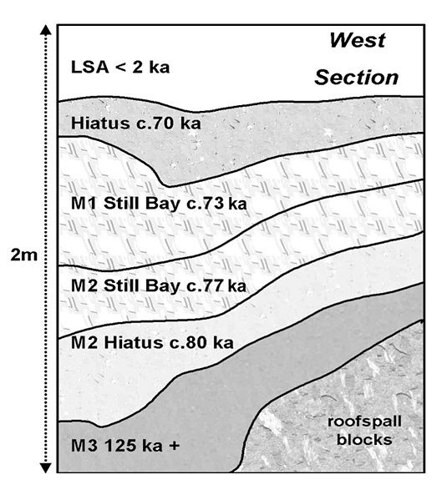 Stratigraphy and dates of the west section of Blombos Cave. The “hiatus” sub-levels contained no cultural features or artifacts. C. Henshilwood, Wikimedia Commons
Stratigraphy and dates of the west section of Blombos Cave. The “hiatus” sub-levels contained no cultural features or artifacts. C. Henshilwood, Wikimedia Commons
__________________________________
Hunting and Fishing
Researchers under the direction of C. Villa and Henshilwood studied the manufacture and use of dozens of Still Bay points (a toolkit named for a site nearby Blombos, characterized by bifacial points with elliptical bases) and other stone tools and fragments which were excavated from Blombos Cave between 1993 and 2004. These lithics all came from the M1 and M2 layers, and most were made of silcrete. Because these researchers were unable, in over a decade of survey and excavation, to find a single source of silcrete closer to Blombos Cave than the alluvial deposits in Riversdale, approximately 30 kilometers away, they inferred that raw materials had been collected in river basins and transported back to the cave for manufacture. The large number of unfinished tools at the site (which comprised more than 80% of the sample set and were found in varying stages of production) allowed the Villa team to physically replicate the manufacturing methods of Blombos Cave’s prehistoric occupants. Their experimental flintknapping revealed that the lithics at Blombos Cave had been constructed by first removing large flakes from a core with a hard stone hammer, then refining the tip and edges by using a softer hammer to remove more delicate flakes. Villa’s team hypothesized that if the lithics at Blombos Cave had been used for hunting, at least some of the tools present would exhibit physical evidence of hafting and of use for cutting meat; morphometric analysis, using comparative collections, revealed that this was indeed the case. The team concluded that the preponderance of lithic evidence, particularly when viewed in conjunction with the other types of artifacts present at this site, is indicative of socially complex hunting behavior, including extensive cooperation and possibly even language and geographic toolkit specialization.
A study led by C. Tribolo and a team in 2006 performed thermoluminescence dating on five silcrete and quartzite lithics from level M1. The internal dose rates were calculated by using delayed neuron activation to measure the concentrations of uranium, thorium, and potassium radioisotopes in the core of each sample, and the external dose rates were measured by a series of dosimeters planted in the stratigraphy for almost one year, as well as by a series of field gamma spectrometer measurements taken throughout the cave. Their results yielded a mean age of 74±5 to 78±6 ka, fairly consistent with the 72.7 ± 3.1 ka date derived from optically-stimulated luminescence of M1 sediments taken by Z. Jacobs and other researchers that same year.
Faunal finds indicated that the MSA people of the cave likely exploited a broad range of animals. This included large animals, such as the eland, and smaller, such as tortoises, mole rats and hyraxes. There was also evidence of seal, dolphin, whale, fish and shellfish in the cave.
___________________________________________
Faunal chart of Blombos Cave. C. Henshilwood, Wikimedia Commons
_________________________________________________________
Personal Adornment
In a study by Francesco d’Errico of the University of Bordeaux, researchers used several methods to study 41 Nassarius kraussianus (sea tick) shells, 39 of which came from level M1 and two of which were from M2. Their goal was to determine whether the wear pattern on these shells–which appeared to have been intentionally perforated and strung together, as for personal adornment–could possibly have formed due to natural processes. Taphonomic analysis indicated that no natural predators of N. kraussianus were present at Blombos Cave during the MSA, and wear use analysis indicated that the condition of the shells was too intact to have been deposited by severe weather patterns. In addition, the mouth of the cave, at 35 meters above sea level, would have been out of reach of ocean waves even during the MSA, and the consistently large size of the shell samples indicates that they were purposefully selected for this attribute. Cost-benefit analysis indicated that the amount of meat yielded by N. kraussianus did not warrant the time required for their collection, leading to the conclusion that sea ticks likely would not have been brought to Blombos Cave as a food source. Experiments with several bead-making techniques revealed that the perforations present in the Blombos Cave shells most resembled the results of intentional piercing with a bone awl or crab claw, and the observed wear use was found to be consistent with friction from rubbing against thread, skin, or other beads. Based on this evidence, the team concluded that the shell artifacts found were anthropogenic in origin and most likely used as necklaces, belts, or other forms of personal ornamentation. The abstract, or symbolic, reasoning inherent in this behavior further attested to the presence of “modern” cognition during the African Middle Stone Age.
________________________________________________
Detail close-up of Blombos shell beads showing intentional perforation. Chris Henshilwood & Francesco d’Errico, Wikimedia Commons
___________________________________________________________
Bonework
D’Errico and Henshilwood also analyzed bone artifacts from the Cave – which included complete awls and awl tips, projectile points, a tool shaft, and three unidentified fragments with possible engravings – in the interest of dating them and confirming or rejecting anthropogenic modification. It is worth noting that only one of these bone artifacts was found in level M3, and its provenience has thus been attributed to turbation processes. D’Errico and Henshilwood used a scanning electron microscope to examine the use wear and markings on the Blombos Cave bones, comparing these findings to various designs and bone wear patterns that they had produced experimentally. They concluded that the bone tools at Blombos were formed by scraping a piece of bone vigorously against a coarse surface or existing tool to form a point, and that some of the bones were intentionally heated to increase their strength before knapping. (Because animal behavior can sometimes result in similar wear patterns, the researchers were careful to consider the taphonomic evidence at Blombos Cave, which in its entirety revealed few animal-induced bone modifications.) The use of morphological comparative collections revealed that the bone tools at this site were used as piercers, scrapers, hafted spear points, and even lithic retouchers, and that their surfaces were smoothed by intensive use. The grooves and lines found in the surfaces of the three unidentified fragments served no clear functional purpose and could not be attributed to any known natural weathering mechanism; the researchers therefore inferred a deliberate and symbolic purpose behind them, even suggesting a similarity between these markings and the engravings of ownership added to arrowheads by contemporary San populations, a practice documented ethnographically.
Art?
Blombos Cave represents an incidence of man-made abstract images dating earlier than 40 ka, including two ochre pieces which were unquestionably engraved and another seven which are suspected to be so. Ochres are considered to be among the earliest pigments used by humans, derived from natural clay containing mineral oxides. The two definitive pieces were found adjacent to a small hearth, with no evidence of turbation present. They each feature a series of cross-hatched lines bound by sets of thicker parallel lines, creating a discrete, recurring geometric pattern. Experimental production techniques revealed that the engraved surfaces were first prepared by grinding against a rough surface, and that the cross-hatched design resulted from at least two separate tool positions relative to the ochre surface, achieved by rotating the ochre during the engraving process. This led to the conclusion that these engravings could not have been the result of accidental or natural processes, and that their origin was categorically anthropogenic.
____________________________________________
Bifacial points, engraved ochre and bone tools from the c. 75 – 80,000 year old M1 & M2 phases at Blombos Cave. C. Henshilwood, photo by Henning, Wikimedia Commons
_______________________________________________________
But perhaps the most significant recent discovery bearing on abstract or artistic expression came during more recent excavations:
An Art Workshop
In 2008, Henshilwood and a team of associates discovered a remarkable assemblage of artifacts while excavating the Cave. The findings included an assortment of lithic hammers and grindstones, and two abalone (sea snail) shells that had evidently been used as containers to hold and store a red, ochre-rich paint mixture that was also mixed with ground bone and charcoal. Ochre, the prime ingredient of the ancient paint, produces the yellow or red color so often associated with the ancient paint and seen to embellish drawings and other works of prehistoric art. It was possibly used for other purposes, such as body decoration. The sediments in which the ochre containers were found were dated to about 100,000 years based on Optically Stimulated Luminescence (OSL) dating.
__________________________________________
Karen van Niekerk excavating the Tk1 toolkit with abalone shell in the 100,000 year old levels at Blombos Cave in 2008. Image courtesy Science/AAAS.
__________________________________
The use of the ancient paint in human history was previously well documented only after about 60,000 years ago, which means that the Blombos Cave finds push back the use of the paint to earlier periods. The finds also indicate that humans as far back as 100,000 years ago were methodically producing and storing the material, representing a critical point in human thinking within the context of human evolution. “The recovery of these toolkits adds evidence for early technological and behavioural developments associated with humans and documents their deliberate planning, production and curation of pigmented compound and the use of containers,” said Henshilwood. “It also demonstrates that humans had an elementary knowledge of chemistry and the ability for long-term planning 100,000 years ago.”
The earliest behaviorally modern humans?
D’Errico, Henshilwood and Tribolo have all noted that while no single line of archaeological evidence at Blombos Cave is conclusive enough to shift our understanding of behavioral modernity and its origins, the implications become clear when the scope of inquiry is widened to the site in its entirety. Systematic lithics production, extensive shell bead manufacture with probable decorative intent, production of bone tools for both practical and symbolic functions, and abstract ochre engravings and a painting “workshop” or tool assemblage: all work in conjunction to challenge the traditional belief that modern thought and behavior patterns were out of reach of Middle Stone Age populations, or that early Europeans were responsible for the rise of human thought as we know it. According to these researchers, the assemblage at Blombos Cave provides ample reason to suspect that this site’s MSA population possessed a spoken language, resided in the cave in social groups, and relied on cooperation for survival. (See the video below).
They have nonetheless tempered their interpretation with a cautious consideration of the evidence, noting that additional data from new sites may be needed before greater confidence can be obtained. They also note that more research needs to be done to determine how past climate variability impacted technological change among early Homo sapiens groups in the region. Were environmental factors a driving force for innovation?
On this point, scientists have recently obtained environmental records from various archaeological sites that suggest climate may not have directly effected cultural and technological innovations of Middle Stone Age humans in southern Africa.* They analyzed animal remains, shellfish taxa, and carbon and oxygen isotope measurements from ostrich eggshell remains sampled from Blombos Cave and Klipdrift Shelter, another cave site with Middle Stone Age deposits and lithics on the southern Cape of South Africa, ranging from 98,000 to 73,000 years ago and 72,000 to 59,000 years ago, respectively. The purpose was to develop data relating to the possible palaeoenvironmental conditions in southern Africa of those time periods. The results showed no clear correlation between the paleoenvironmental changes and the patterns and changes in the archaeological record at each site.
This is significant within a larger debate, which revolves around the suggestion by some scientists that climate instability may have catalyzed technological advances, while others have suggested the opposite—that environmental stability may have allowed for experimentation. Now, the disconnect between palaeoenvironmental records and the archaeological sites complicates the testing of these alternatives.
The importance of sharing technology and culture
Researchers have also been studying the technology used by different groups in South Africa, including objects such as stone spear points and decorated ostrich eggshells, to determine if there was any overlap and contact across Middle Stone Age human groups. The results produced some revelatory insights.
“The pattern we are seeing is that when demographics change, people interact more. For example, we have found similar patterns engraved on ostrich eggshells in different sites. This shows that people were probably sharing symbolic material culture at certain times but not at others” says Dr Karen van Niekerk, a key researcher.
The sharing of symbolic material culture and technology can provide some clues relating to the success of Homo sapiens‘ dispersal from Africa to Arabia and Europe. The greater the inter-group contact and interaction, the more sophisticated and defined their technology and culture became.
“Contact across groups, and population dynamics, makes it possible to adopt and adapt new technologies and culture and it is what describes Homo sapiens. What we are seeing is the same pattern that shaped the people in Europe who created cave art many years later,” Henshilwood says.
____________________________________
________________________________________________
*According to a study published July 6, 2016 in the open-access journal PLOS ONE by Patrick Roberts from the University of Oxford, UK, and colleagues.
________________________________________________
Authors: Michael Gordon, Faithe McCreery, and Dan Mclerran
____________________________________

______________________________________________
Travel and learn with Far Horizons.
____________________________________________
This richly illustrated issue includes the following stories: Recent findings shedding new light on the whereabouts of the remains of Philip of Macedon, father of Alexander the Great; how an archaeologist-sculptor is bringing bones of the dead back to life; archaeologists uncovering town life at the dawn of civilization; an exclusive interview with internationally acclaimed archaeologist James M. Adovasio about what makes the Meadowcroft Rockshelter prominent in the ongoing search for the first Americans; what archaeologists are finding at the site of the ancient city of Gath, the home town of the biblical Philistine giant, Goliath; and how scientists are redrawing the picture of human evolution in Europe. Find it on Amazon.com.


